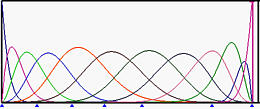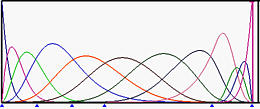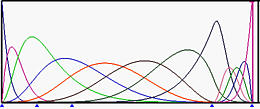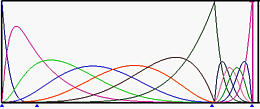

Let us recall the definition of the B-spline basis functions as follows:

This set of basis functions has the following properties, many of which resemble those of Bézier basis functions.

This observation can be generalized easily. In fact, ignoring the change of knot span endpoints, to create a knot of multiplicity k, k-1 basis functions will be affected. One of them loses one knot span, a second of them loses two, a third of them loses three and so on.





The above shows the basis functions of degree 5 where the left end and right end knots have multiplicity 6, while all middle knots are simple (left on top row). The top right figure is the result of moving u5 to u6. Those basis functions ended at u6 have fewer knot spans on which they are non-zero. In the middle row figures, u4 and then u3 are moved to u6, making u6 a knot of multiplicity 4. The bottom row figure shows the result after moving u2 to u6, creating a knot of multiplicity 5.
In the above figures, since the multiplicity of knot u6 are 1 (simple), 2, 3, 4 and 5, the numbers of non-zero basis function at u6 are 5, 4, 3, 2 and 1.